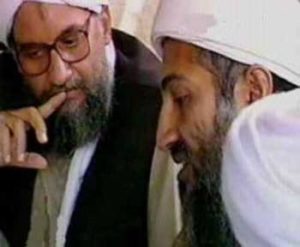Abu Bakr al-Baghdadi’s Islamic State of Iraq and Sham (ISIS), the leading jihadi fighting force in northern Syria, is often described as “an al-Qaeda group.” Its historical ties to Ayman al-Zawahiri’s al-Qaeda Central (AQC) notwithstanding, this characterization is unhelpful and possibly misleading. The Islamic State, in its own conception, is no ordinary jihadi group; nor is it strictly beholden to al-Qaeda as such. Describing ISIS in this way, moreover, overlooks the dramatic rupture that has set in between the Islamic State and AQC over the past several months.
Today ISIS persists in a state of outright disobedience to its supposed seniors in AQC, Zawahiri among them. The following examines both the extent of this state of disobedience and the nature of the Islamic State itself that has given rise to it.
Anguished forums
Shumukh al-Islam, al-Qaeda’s semi-official online forum, signaled alarm last week over enduring tensions between ISIS and Jabhat al-Nusra (JN), the al-Qaeda-aligned jihadi group in Syria that al-Baghdadi secretly organized in summer 2011 but now pledges allegiance (bay‘a) exclusively to Zawahiri. Evidently, ISIS and JN are engaged in a war for influence on the jihadi internet. In its very first Tweet, @shomokhalislam complained of being caught in the middle of this fight dividing the jihadi community: staunch supporters of ISIS and JN issuing demands to the forum to censor and delete rival content. Shumukh vowed to maintain a neutral stance in the dispute and, in the spirit of jihadi unity, threatened to terminate the account of any user casting aspersions on one side or the other. For more positive encouragement, it posted a doctored photo of JN and ISIS fighters standing together beside the caption, “Hand in hand…brothers in faith and religion.”
The Shumukh statement and threat owe much to the recent ascendancy in the Syrian jihad of ISIS and its much-vaunted emir, Abu Bakr al-Baghdadi. Aymenn Jawad Al-Tamimi and Joas Wagemakers recently noted the increasing level of jihadi support for al-Baghdadi, in both public displays of support worldwide and in jihadi ideological production (see here and here). All this reflects an intra-jihadi conflict opposing ISIS to both JN and AQC. While Syria’s jihadis on the ground may have achieved a modus vivendi in many areas (JN and ISIS fighters have been filmed playing tug-of-war in Aleppo), tensions in jihadi media remain pronounced.
A case decided
The Shumukh administrators are not the first jihadis to try to mediate the ISIS-JN dispute. To remind readers, this dispute broke out in April last year when al-Baghdadi, emir of the then-Islamic State of Iraq (ISI), declared JN to be a mere “extension” of ISI and henceforward dissolved. Simultaneously, he extended the Islamic State’s writ to Sham, or greater Syria, thus begetting the Islamic State of Iraq and Sham (ISIS). When JN’s leader, Abu Muhammad al-Jawlani, rejected al-Baghdadi’s instruction to disband, Ayman al-Zawahiri stepped into the fray to “decide the case.”
In late May he issued a written directive, leaked to al-Jazeera, pronouncing against al-Baghdadi. The AQC emir annulled the Islamic State’s incorporation of Syria, ordering ISI and JN to remain separate entities observing separate jurisdictions—Iraq and Syria respectively.
Zawahiri, however, had overestimated the weight of his authority. From the Islamic State’s perspective, it was he, and not al-Baghdadi, who had overstepped his bounds.
2549 days and counting
The first thing one sees on many jihadi web forums (www.shamikh1.info/vb, www.alfidaa.org/vb/, www.alplatformmedia.com/vb/, among others) is a banner marking time passed since the Islamic State’s founding in 2006. Today the banner reads: “2549 days have passed since the announcement of the Islamic State and the umma’s forthcoming hope…and it will continue to persist by the will of God.” The symbolic centrality of the Islamic State across jihadi media goes some way in explaining the current outlook of the Islamic State qua a state—not a group—and its wide appeal among jihadis.
While it began as a purely Iraqi entity—announced on October 15, 2006 by a “council” of eight jihadi groups including the infamous al-Qaeda in Mesopotamia—the Islamic State has since its very beginning entertained a vision of limitless territorial expansion. In its founding statement, the state’s anonymous spokesman claimed to draw inspiration from the model of the original Islamic State (al-dawla al-islamiyya) founded in 622 by the Prophet Muhammad in Medina, whence it became the capital of the caliphate and global Islamic empire.
This prophetic model has been a standard feature of the Islamic State’s propaganda and intellectual production. A 90-page document from 2006 explaining the state’s raison d’être, authored by a member of ISI’s Shari‘a Council, likewise portrayed ISI as “the new Islamic state”: “This state of Islam has arisen anew to strike down its roots in the region, as was the religion’s past one of strength and glory.” As to its claimed jurisdiction, the author wrote: “There exists no legal proof-text from the Qur’an or sunna stipulating a decreed limit to the territorial expanse on which the Islamic state ought to be erected.”
Zawahiri, for his part, spoke similarly of the Islamic State’s unique role as the proto-caliphate. In a 2009 question-and-answer forum he stated: “The State [i.e., ISI] is a step on the path to establishing the caliphate. It is superior to mujahid groups. These organizations [in Iraq] must give allegiance to the State, not vice versa.”
Problem child
Beyond public pronouncements, AQC and ISI do not seem to have ever enjoyed happy relations. The Abbottabad documents in fact indicate that AQC never approved of the Islamic State’s establishment and that a leadership-to-leadership relationship hardly ever existed. This is at least according to American al-Qaeda spokesman Adam Gadahn, who in 2011 recommended that al-Qaeda publicly “sever its ties with the Islamic State of Iraq.” Gadahn feared that ISI’s engagement in sectarian violence had tarnished al-Qaeda’s reputation.
While AQC leaders did not follow his advice, ties between al-Qaeda and the Islamic State were indeed to become practically severed—on the initiative, however, of the Islamic State.
Rupture
Some three weeks following Zawahiri’s leaked decree, Abu Bakr al-Baghdadi, who in mid-2010 succeeded Abu ‘Umar al-Baghdadi as emir of the Islamic State with the latter’s death in an American bombing, signaled the rupture with AQC. In a seven-minute audio statement issued June 15, al-Baghdadi decried “the document attributed to Shaykh Ayman al-Zawahiri.” He declared defiantly: “The Islamic State of Iraq and Sham shall endure, so long as we have a vein that pulses and an eye that bats.” He added, in a nod to its expansionist nature, that “[the Islamic State] shall not retreat from any spot of land to which it has expanded, and it shall not diminish after enlarging.” Zawahiri’s was a “command at variance with the command of God,” unacceptable on account of “numerous legal and methodological objections.” The decision to defy Zawahiri, he said, was made not by him alone but rather in consultation with the Islamic State’s Shura Council and in accordance with the ruling of its Shari‘a Council.
Al-Baghdadi was firm yet respectful in this rejoinder. It was left to another ISIS leader, Islamic State “official spokesman” Abu Muhammad al-‘Adnani, a Syrian, to sharpen the tone.
Ayman who?
The Syrian al-‘Adnani, in a follow-up audio message to al-Baghdadi’s, denounced Zawahiri’s edict more aggressively and systematically. “No one,” he thundered, “will stop us from aiding our brethren in Syria! No one will stop us from fighting the ‘Alawis and waging jihad in Syria! No one will stop us from remaining in Syria! Iraq and Syria will remain one theater, one front, one command!” “Car bombs,” he threatened, “will strike the shi‘a (rawafid), from Diyala to Beirut…and we will repel the ‘Alawis and Hizballah.”
Al-‘Adnani elaborated on seven “objections” to Zawahiri’s order. First, it was an order to commit a sin (ma‘siya) in the form of dividing the ranks of the mujahidin: splitting a united fighting force into an Iraqi and a Syrian force and thus weakening the community. Second, it affirmed the Sykes-Picot division of the Arab Middle East into artificial nation-states like “Iraq” and “Syria,” a division without basis in Islam. Third, it validated those “disobedient renegades” in the JN leadership who split, unlawfully, from the Islamic State by withdrawing bay’a from al-Baghdadi. Fourth, it set a precedent for other factions within the Islamic State to branch off and declare their independence. Fifth, Zawahiri’s judgment was made without properly consulting either party to the dispute, not to mention that the JN leadership’s testimony would be invalid on account of their sinning. Sixth, JN’s public rejection of al-Baghdadi’s ISIS announcement had gratified the enemies of the mujahidin and divided the community; this was not on par with the error Zawahiri attributed to the Islamic State of mistiming the announcement of its expansion to Syria. Seventh, Zawahiri was demanding that the mujahidin and their leadership withdraw from Syria at a time when all the mujahidin in the world were trying to join the fight there—a senseless demand.
The Islamic State, it would appear, does not recognize—at least for the moment—the higher authority of AQC. On July 29, the seventh anniversary of the Islamic State’s founding according to the Islamic calendar, al-‘Adnani issued yet another audio address reaffirming its expansionist doctrine in contravention of Zawahiri’s decree. “Our objective,” he averred, “is the formation of an Islamic state on the prophetic model that acknowledges no boundaries, distinguishes not between Arab and non-Arab, easterner and westerner, but on the basis of piety. Its loyalty is exclusively to God: it relies on only Him and fears Him alone.”
Bay‘a for al-Baghdadi
Apart from repudiating Zawahiri, ISIS’s recent media efforts have focused on promoting bay‘a, or the pledge of allegiance, to al-Baghdadi. In large measure this seems aimed at discrediting JN’s al-Jawlani, but it is also a more general effort to attract new Islamic State loyalists. One example of the effort is a widely publicized nashid (religiously sanctioned chant or anthem) calling on listeners to “close ranks and give allegiance to al-Baghdadi,” described as “our emir of Iraq and Sham.” Another item of interest is a short essay by a Syrian ISIS member explaining to readers “why I chose the State,” and why they should too. In short, the reason is that its leader dealt a severe blow to the Sykes-Picot division of the Middle East by expanding to Syria and that his Islamic State has the momentum to carry it to Jerusalem.
Even greater effort in promoting bay‘a for al-Baghdadi has come from beyond ISIS’s media organs in the form of lengthy treatises by big-name jihadi scholars like the Jordanian Abu Humam al-Athari. Joas Wagemakers has detailed al-Athari’s arguments, which center on al-Baghdadi’s peerless credentials as a scholar and warrior. Two other jihadi scholars worth noting here are the Tunisian Abu Ja‘far al-Hattab, a member of the Shari‘a Council of Ansar al-Shari‘a in Tunisia, and the more anonymous Abu al-Hasan al-Azdi, who appears connected to the Shumukh forum.
In his treatise, al-Hattab discusses at length the institution of bay‘a in Islamic law as a prelude to declaring invalid any bay‘a directed to JN leader al-Jawlani. The thrust of the argument is that al-Baghdadi had received bay‘a first and so al-Jawlani was outside his prerogative in receiving a competing bay’a. Moreover, because al-Jawlani had originally pledged allegiance to al-Baghdadi as a member of ISI, his retraction of that pledge constituted a betrayal and a “grave sin.” The only legitimate bay‘a can be to al-Baghdadi.
In “Obligations for Joining the Islamic State of Iraq and Sham: Objections and Responses,” al-Azdi also stresses the gravity of al-Jawlani’s withdrawal of bay’a from al-Baghdadi. He summarizes his support for al-Baghdadi in a number of points: his eminent qualifications as emir, the legal inadmissibility of giving additional bay‘as, and the Islamic State’s evident superior strength compared with mujahid groups. Finally, al-Azdi argues, even if al-Baghdadi erred in declaring the expansion of the Islamic State to Syria, that State had become a reality that must be accepted in light of the harm that multiple bay‘as in Syria would do to jihadi unity.
Al-Baghdadi triumphant
To be sure, there are jihadi ideologues who have supported JN or taken a more neutral stance on the ISIS-AQC-JN debacle. Journalist Hussein Jamo has identified some of them. The momentum, however, both material and intellectual, appears to favor the Islamic State, al-Baghdadi, and his contempt for Zawahiri’s effort to restrain him.
The sudden ascendancy of al-Baghdadi marks a signal achievement for the defiantly reborn Islamic State. Contrary to popular perceptions, this achievement is in no way a triumph for AQC but rather comes at its expense. Al-Baghdadi, the rising standard-bearer of the jihadi ideology traditionally undergirding al-Qaeda, appears for the moment the triumphant leader of something quite distinct from an “al-Qaeda group.”





10 Responses